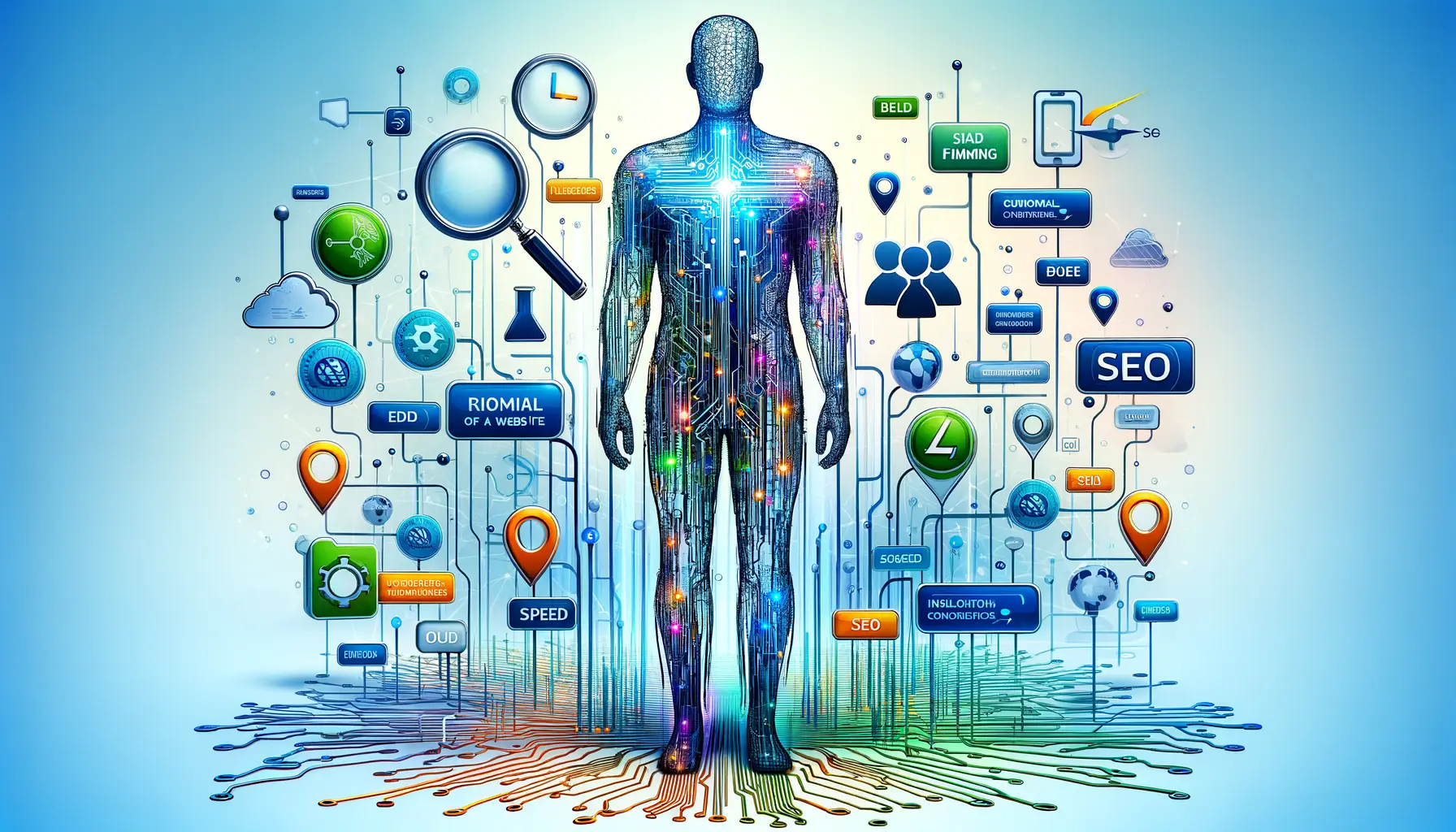The digital landscape is evolving, and with it, the tools and technologies that shape our online experiences.
Among these, Headless Content Management Systems (CMS) have emerged as a pivotal force, redefining how content is managed and delivered across the web.
This shift has significant implications for Technical SEO, a critical aspect of digital marketing that ensures websites are structured and optimized for search engine algorithms.
The intersection of Headless CMS and Technical SEO marks a new frontier in the quest for digital visibility and user engagement.
At its core, a Headless CMS decouples the backend content management from the frontend presentation layer.
This separation allows developers to use APIs to deliver content across multiple platforms, such as websites, mobile apps, and IoT devices, without being tied to a specific frontend framework.
This flexibility is a boon for developers but introduces new challenges and opportunities for Technical SEO.
The traditional SEO playbook, designed for monolithic CMS architectures, must be reevaluated and adapted to harness the potential of Headless CMS fully.
- Understanding Headless CMS and Its SEO Advantages
- Challenges and Solutions for SEO in Headless CMS
- Optimizing Site Speed and Performance for SEO
- Enhancing User Experience for SEO Benefits
- Building a Content Strategy with Headless CMS
- Link Building and Headless CMS
- Adapting to Algorithm Updates with Headless CMS
- Embracing the Future with Headless CMS and Technical SEO
- Headless CMS and SEO FAQs
Understanding Headless CMS and Its SEO Advantages
What is Headless CMS?
A Headless CMS is a back-end only content management system that provides a way to author content, but instead of having a built-in frontend to display it, it offers an API that allows the content to be consumed on any frontend platform.
This architecture provides unparalleled flexibility in how and where content is displayed, enabling businesses to deliver a consistent content experience across diverse digital touchpoints.
The separation of content from presentation has profound implications for SEO.
Without the constraints of a traditional CMS, developers can implement cutting-edge web technologies that improve site speed, enhance user experience, and ultimately contribute to better search engine rankings.
However, this freedom also requires a strategic approach to SEO to ensure that the headless architecture does not dilute or undermine search visibility.
SEO Advantages of Using a Headless CMS
The use of a Headless CMS offers several SEO advantages that can significantly impact a website’s performance in search rankings.
One of the most notable benefits is the improvement in website speed.
Since the frontend is developed independently, it can be optimized for performance without the overhead of a traditional CMS.
Faster websites not only provide a better user experience but are also favored by search engines, contributing to higher rankings.
Another advantage is the flexibility in implementing SEO best practices.
With a Headless CMS, SEO elements like meta tags, structured data, and canonical URLs can be managed more efficiently, allowing for precise control over how content is indexed and displayed by search engines.
This level of control is crucial for optimizing website visibility and ensuring that content reaches its intended audience.
The strategic implementation of a Headless CMS can lead to significant SEO benefits, including faster website speeds and more precise control over SEO elements.
Challenges and Solutions for SEO in Headless CMS
While the benefits of a Headless CMS for SEO are clear, the architecture also presents unique challenges that require thoughtful solutions.
The decoupling of the frontend and backend means that SEO strategies need to be integrated more deliberately into the development process.
Below, we explore some of these challenges and propose effective solutions to ensure your Headless CMS-powered website ranks well in search engine results.
One of the primary challenges is ensuring that search engines can fully crawl and index content delivered through APIs.
Traditional SEO techniques often rely on the inherent capabilities of a CMS to manage SEO elements.
In a Headless CMS, these capabilities are not automatically available, necessitating a proactive approach to SEO.
Ensuring Content Visibility to Search Engines
- Server-Side Rendering (SSR): Implement SSR to ensure that search engines can crawl and index your website’s content. SSR generates the HTML content on the server, allowing search engines to see the content as users do.
- Dynamic Rendering: For websites that rely heavily on JavaScript, dynamic rendering serves a static version of the content to search engines while maintaining a rich, interactive experience for users.
Managing SEO Elements in a Headless Environment
- Meta Tags and Structured Data: Develop a system within your Headless CMS to manage meta tags, structured data, and other SEO-relevant information. This often involves creating custom fields and integrating with SEO tools.
- URL Structure: Maintain clean, descriptive URLs and implement 301 redirects as needed. A Headless CMS should allow for the customization of URL structures to support SEO.
Building a Sitemap and Robots.txt
Creating and maintaining a sitemap is crucial for SEO success in a Headless CMS.
A sitemap helps search engines discover and index all the pages on your site.
Similarly, a well-configured robots.txt file can guide search engine crawlers to the content that matters most and away from duplicate or irrelevant pages.
- Automate the generation of sitemaps to include all current pages and update as new pages are added.
- Customize the robots.txt file to ensure efficient crawling by search engines, avoiding the indexing of system pages or pages with thin content.
Integrating SEO into a Headless CMS requires a blend of technical and strategic approaches. By addressing these challenges head-on, businesses can leverage the flexibility of Headless CMS without sacrificing search engine visibility.
Optimizing Site Speed and Performance for SEO
Site speed and performance are critical factors in SEO and user experience.
A Headless CMS architecture offers unique opportunities to optimize these aspects, but it also requires a strategic approach to fully leverage its potential.
Here, we delve into how optimizing site speed and performance within a Headless CMS environment can significantly enhance SEO outcomes.
Improving site speed involves a combination of front-end and back-end optimizations.
In a Headless CMS, the separation of content management from content delivery allows for more targeted optimizations, focusing on both the efficiency of content delivery and the performance of the user interface.
Front-end Optimization Strategies
- Utilize modern JavaScript frameworks like React or Vue.js for efficient, dynamic content rendering.
- Implement lazy loading for images and videos to reduce initial page load time.
- Minimize CSS and JavaScript file sizes through minification and compression.
- Adopt responsive design practices to ensure fast loading times across devices.
Back-end Optimization Techniques
- Enable server-side rendering (SSR) to improve the crawlability of JavaScript-heavy sites by search engines.
- Use Content Delivery Networks (CDNs) to reduce latency by serving content from locations closer to the user.
- Optimize API response times by caching responses and minimizing payload sizes.
- Regularly audit and optimize database queries to prevent bottlenecks in content delivery.
Monitoring and Continuous Improvement
Optimizing for speed and performance is an ongoing process.
Tools like Google’s PageSpeed Insights and Lighthouse provide valuable insights into how well your site performs and offer recommendations for improvement.
Regularly monitoring these metrics and implementing suggested optimizations can lead to significant improvements in site speed, user experience, and SEO rankings.
A proactive and continuous approach to optimizing site speed and performance within a Headless CMS framework can lead to substantial SEO benefits, enhancing both user satisfaction and search engine rankings.
Enhancing User Experience for SEO Benefits
User experience (UX) has become an integral part of SEO, with search engines like Google placing increasing importance on how users interact with websites.
A Headless CMS offers the flexibility to craft tailored user experiences, but this also means UX must be a central consideration in the development process to reap the SEO benefits.
Enhancing UX involves understanding user needs and behaviors and then designing the website to meet those needs as efficiently and enjoyably as possible.
In a Headless CMS environment, this often means leveraging the system’s flexibility to create dynamic, user-focused interfaces.
Creating Intuitive Navigation
- Design a clear, logical site structure that allows users to find information quickly.
- Implement a responsive menu that adapts to various devices and screen sizes.
- Use breadcrumb navigation to help users understand their location within the site and navigate back to previous sections easily.
Improving Content Accessibility
- Ensure that all content is easily accessible, regardless of the device or browser being used.
- Adopt best practices for web accessibility, including proper use of HTML semantic elements and ARIA labels, to make content accessible to all users, including those with disabilities.
- Utilize a Headless CMS’s API to deliver content in various formats, catering to different user preferences and needs.
Optimizing for Mobile Users
With mobile traffic accounting for a significant portion of web usage, optimizing for mobile users is crucial.
A Headless CMS allows for the development of Progressive Web Apps (PWAs) and other mobile-first designs that offer app-like experiences in a mobile browser.
This not only improves UX but also positively impacts SEO, as mobile-friendliness is a key ranking factor.
A focus on enhancing user experience aligns with SEO goals, as search engines reward sites that provide value and satisfaction to users. By leveraging the capabilities of a Headless CMS to improve UX, businesses can achieve better engagement, lower bounce rates, and higher search rankings.
Building a Content Strategy with Headless CMS
Content is the cornerstone of SEO, and a Headless CMS provides a dynamic and flexible platform for managing and delivering content across multiple channels.
However, to fully leverage the SEO benefits of a Headless CMS, it’s crucial to develop a comprehensive content strategy that aligns with your SEO goals and audience needs.
Creating a content strategy involves understanding your target audience, defining your content goals, and determining how best to use the Headless CMS to meet those goals.
This strategic approach ensures that your content not only engages your audience but also supports your SEO objectives.
Identifying Target Audience and Content Needs
- Conduct audience research to understand the interests, needs, and search behaviors of your target audience.
- Segment your audience to tailor content more effectively to different groups within your target market.
- Use insights from audience research to create personas that guide content creation and delivery.
Developing a Multi-Channel Content Plan
- Map out a content plan that includes various types of content (articles, videos, infographics) to be distributed across different channels (website, social media, email).
- Leverage the Headless CMS’s API to automate content distribution, ensuring consistent and timely content delivery across all platforms.
- Plan for content personalization and dynamic content delivery based on user behavior and preferences to increase engagement and relevance.
Measuring Content Performance and SEO Impact
To ensure your content strategy is driving the desired SEO results, it’s essential to measure content performance and its impact on SEO metrics.
Use analytics tools to track key performance indicators (KPIs) such as traffic, engagement, conversion rates, and keyword rankings.
Analyzing this data allows you to refine your content strategy over time, focusing on what works best for your audience and your SEO objectives.
A well-crafted content strategy is vital for maximizing the SEO benefits of a Headless CMS. By focusing on audience needs, multi-channel content delivery, and performance measurement, businesses can create compelling content that boosts SEO performance and drives business results.
Link Building and Headless CMS
Link building remains a fundamental aspect of SEO, influencing how search engines perceive the authority and relevance of a website.
In the context of a Headless CMS, the approach to link building doesn’t change, but the flexibility and control over content presentation can be used to enhance link acquisition strategies.
Effective link building with a Headless CMS involves creating high-quality, link-worthy content and leveraging the system’s capabilities to promote content across various channels.
Here’s how to approach link building in a Headless CMS environment to improve SEO performance.
Creating Link-Worthy Content
- Focus on producing high-quality content that addresses the needs and interests of your target audience. This includes comprehensive guides, industry insights, original research, and interactive content.
- Use the Headless CMS to manage and update content easily, keeping it relevant and valuable to encourage natural link acquisition.
Promoting Content Across Channels
- Leverage the API-driven nature of a Headless CMS to distribute content seamlessly across multiple platforms, including social media, email newsletters, and partner websites, increasing its visibility and link-building potential.
- Engage with your community through comments, forums, and social media to drive traffic to your content and encourage shares and links.
Building Relationships for Link Acquisition
Building relationships with influencers, industry leaders, and complementary businesses can lead to high-quality backlinks.
Use your Headless CMS to create guest content, co-branded initiatives, or featured articles that can be shared with partners’ audiences, providing mutual value and earning authoritative links back to your site.
Leveraging the capabilities of a Headless CMS for link building requires a focus on quality content, strategic promotion, and relationship building. By adopting these strategies, businesses can enhance their link profile, improve SEO performance, and drive greater visibility in search engine results.
Adapting to Algorithm Updates with Headless CMS
Search engine algorithms are constantly evolving, with updates that can significantly impact SEO strategies and website rankings.
A Headless CMS, with its flexible architecture and content delivery capabilities, offers unique advantages in adapting to these changes.
However, staying ahead requires vigilance and a proactive approach to SEO management.
Adapting to algorithm updates in a Headless CMS environment involves staying informed about SEO trends, analyzing the potential impact of changes, and quickly implementing necessary adjustments to content and technical SEO elements.
Staying Informed on SEO Trends
- Regularly follow reputable SEO news sources and forums to stay updated on algorithm changes and industry best practices.
- Participate in SEO communities and attend webinars or conferences to gain insights from experts and peers.
Analyzing Algorithm Updates
- Use analytics tools to monitor your website’s performance metrics closely, looking for signs of impact from algorithm updates.
- Conduct a thorough analysis of content and technical SEO aspects to identify areas that may need adjustment in response to the latest SEO trends.
Implementing Quick Adjustments
- Leverage the Headless CMS’s flexibility to quickly update content, meta tags, and structured data to align with new SEO best practices.
- Collaborate with developers to make technical SEO adjustments, such as improving site speed or mobile responsiveness, to meet the latest search engine guidelines.
By adopting a flexible and informed approach to SEO, businesses using a Headless CMS can effectively navigate the challenges of algorithm updates.
This proactive stance not only helps in maintaining or improving search rankings but also ensures that the website continues to deliver a superior user experience, aligned with the latest SEO standards.
Adapting to search engine algorithm updates is crucial for maintaining SEO performance. A Headless CMS provides the agility needed to respond quickly, but success depends on staying informed, analyzing changes, and implementing timely adjustments.
Embracing the Future with Headless CMS and Technical SEO
The journey through the intricacies of Headless CMS and its impact on Technical SEO reveals a landscape ripe with opportunities and challenges.
As we’ve explored, the Headless CMS architecture offers unparalleled flexibility and efficiency in content management and delivery, setting the stage for innovative SEO strategies that can propel websites to new heights in search engine rankings.
Key Takeaways for Maximizing SEO with Headless CMS
- The separation of content management from presentation in Headless CMS requires a strategic approach to SEO, ensuring content is both accessible and optimized for search engines.
- Site speed and performance are critical SEO factors that benefit from the Headless CMS architecture, emphasizing the need for front-end and back-end optimization.
- User experience, shaped by intuitive navigation and mobile responsiveness, plays a pivotal role in SEO success, underscoring the importance of designing with the user in mind.
- A robust content strategy, supported by Headless CMS, is essential for engaging the target audience and achieving SEO goals, highlighting the need for quality, relevance, and multi-channel distribution.
- Effective link-building practices remain fundamental in a Headless CMS context, focusing on creating link-worthy content and fostering relationships for backlink acquisition.
- The agility of Headless CMS is a significant advantage in adapting to search engine algorithm updates, allowing for quick implementation of SEO adjustments.
In conclusion, the impact of Headless CMS on Technical SEO is profound, offering a forward-thinking approach to managing and optimizing digital content in an ever-evolving online ecosystem.
By embracing the advantages and addressing the challenges associated with Headless CMS, businesses can unlock the full potential of their online presence, ensuring they not only keep pace with but also anticipate the demands of modern SEO.
The future of digital content management and optimization lies in the strategic integration of Headless CMS and Technical SEO, paving the way for enhanced visibility, engagement, and success in the digital realm.
Want your website to top Google search rankings? Leave the SEO to our professional agency!
Headless CMS and SEO FAQs
Exploring the nuances of Headless CMS and its impact on SEO, we’ve compiled a list of frequently asked questions to shed light on common inquiries and concerns.
Yes, Headless CMS can significantly benefit SEO by offering faster site speeds, improved user experience, and greater flexibility in content management and delivery.
Headless CMS can enhance site speed by allowing developers to use modern web technologies and frameworks, leading to faster page load times and better SEO rankings.
Absolutely. By enabling content delivery across multiple platforms seamlessly, Headless CMS ensures a consistent and engaging user experience, positively impacting SEO.
The main challenges include ensuring content is crawlable by search engines, managing SEO metadata, and creating a sitemap, all of which require custom development.
SEO metadata management in Headless CMS involves creating custom fields for titles, descriptions, and other metadata, and integrating with SEO tools for optimization.
Yes, the flexibility of Headless CMS allows for the development of responsive designs and mobile-first experiences, crucial for mobile SEO and user engagement.
Optimizing content involves keyword research, creating high-quality and relevant content, and using the Headless CMS’s API to distribute content effectively across channels.
Yes, the agility of Headless CMS allows for quick updates to content and SEO strategies, helping websites stay aligned with the latest search engine algorithm changes.










